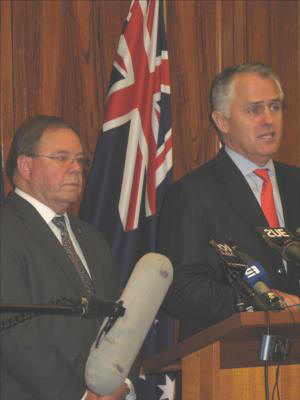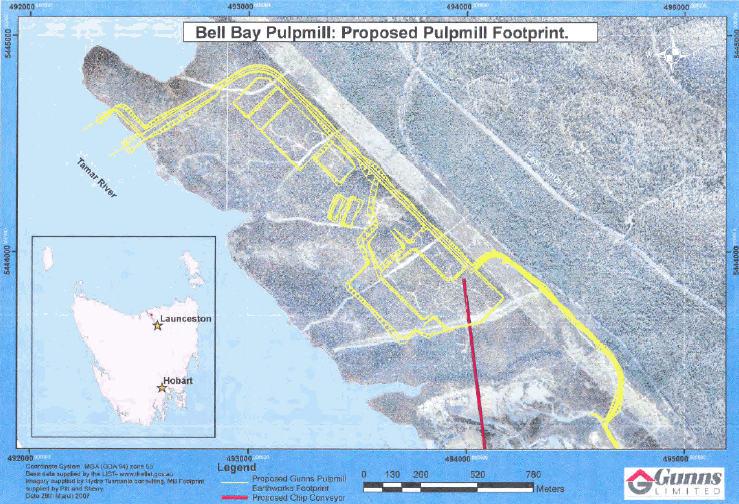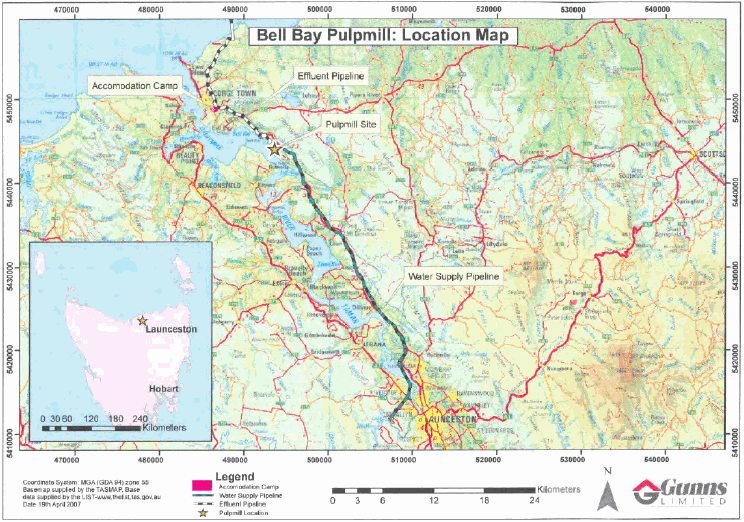|
News & Views item - October 2007 |
Federal Environment Minister Malcolm Turnbull Lists 45 Conditions to be
Met for Gunns' Bell Bay Pulp Mill to Proceed. (October 4, 2007)
 |
|
Chief Scientist, Jim Peacock (L) with Minister for the Environment Malcolm Turnbull |
The federal Minister for the Environment, Malcolm Turnbull, with Chief Scientist, Jim Peacock at his side announced what appears to be an each-way bet as regards the decision to allow Gunns, Limited to construct and run a $1.7 billion pulp mill at Bell Bay, Tasmania.
There are 45 conditions for approval which are listed below. It remains to be seen whether or not Gunns will accept them, meet those required prior to beginning construction and then proceed.
Following Mr Turnbull's announcement, Green's leader, Senator Bob Brown
condemned the decision to approve the mill, saying it is not world's
best practice: "Malcolm Turnbull is going to require 400 hectares of
bush near the pulp mill to be protected while he gives the go ahead for
200,000 hectares of magnificent forest beyond the hills, which are going
to be fed into this pulp mill to be destroyed."
He added that the mill cannot be viewed as world's best practice,
because it will be using logs from native forests: "In this day and age
we should have a closed loop, plantation-based pulp mill, away from an
urban environment and a crop-growing area. We've always said, the
technology is available for an environmentally-friendly pulp mill. This
is an environmental ogre."
Taking Senator Brown's figure of 200,000 hectares that equates to 772 square miles or a paddock of 28 miles x 27.8 miles. Or perhaps think of drawing a circle with a radius of 15.7miles (25Ό km) from the CBD of Sydney or Melbourne or in fact from the proposed site of the pulp mile to the outskirts of Launceston.
It's interesting to note a sentence from the Chief Scientist's report: (section 1.1.6) ...The potential impact of wood supply to the mill is exempt from assessment by the Commonwealth under S.75 of the Environment Protection and Biodiversity Conservation Act 1999.
[See also: http://abc.net.au/science/news/stories/2007/2051656.htm]
Below are two maps taken from the Minister's document "Decision to approve the taking of an action" , followed by URLs supplied by the Minister for the Environment to the decision itself, the Chief Scientist's report and two "fact sheets". Finally there is the list of the 45 conditions Gunns must meet.


More information on the Chief Scientists panel and Terms of Reference is also available at
Click here to download the Chief Scientist's Report
Click here to view the Minister's decision regarding the proposed Tamar Valley Pulp Mill
Fact Sheets
Summary of conditions for the Gunns Limited proposed pulp mill
Environmental Impact Management Plan
Gunns Limited must develop and submit an EIMP in accordance with
conditions
specified by the Minister.
The EIMP must be developed in consultation with an independent expert
group
(the Independent Expert Group), appointed by the Minister, drawn from
leading
national and international scientists with relevant expertise. This
group will advise
the Minister and the Department as required and assist in the design,
implementation, monitoring and approval of the EIMP.
Some elements of the EIMP will be required to be approved prior to
construction.
No commissioning activity is to commence until the final and complete
EIMP has
been approved by the Minister. Once approved, the EIMP must be
implemented.
An independent site supervisor (the Independent Supervisor) will be
appointed by
the Minister to independently monitor compliance with the conditions.
The
supervisor will have the full range of powers as an inspector under the
Environment
Protection and Biodiversity Conservation Act 1999 to ensure there are no
impediments in terms of access to information or locations to the
performance as
supervisor.
Extensive modelling and monitoring of the environment, including in
sentinel species, is
required as part of the EIMP to ensure any unforeseen impacts on the
environment are
detected quickly.
Gunns Limited must agree to specific remedial changes to pulp mill
processes and
operation in the event specified trigger points to any part of the
environment are
breached.
There is a guarantee that, if maximum limits for effluent discharge are
reached and
cannot be reduced within stipulated timeframes, the pulp mill will cease
to operate until
tertiary treatment of effluent is installed.
Gunns Limited must submit an annual report of performance against the
requirements of
the EIMP each financial year. The report must identify any requirements
of the EIMP
that have not been satisfied and appropriate strategies for meeting
these requirements.
The annual report must be independently audited by an appropriately
qualified person
agreed to by the Department. The annual report must be published by
Gunns Limited
within ten business days of the completion of the independent audit.
If there are any problems identified in the annual report, Gunns Limited
will be required
to rectify those problems in accordance with directions from the
Minister.
Listed Flora and Fauna
Wedge-tailed Eagle
Construction must not commence, within defined distances of a nest site,
during the
breeding season of the Wedge-tailed Eagle. Work is to stop if a new nest
is found
within the defined distances.
An ecologist approved by the Department must conduct approved monitoring
of the
Wedge-tailed Eagle nest.
If the nest is abandoned, within set times, the proponent must take
remedial action
agreed by the Australian Government.
Similar provisions are included for the listed migratory White-bellied Sea-eagle.
New and enhanced habitat
Conditions imposed will lead to around 400 hectares of land being set
aside for
protected plants and animals.
Gunns Limited will be required to rehabilitate at least 200 hectares of
land, outside
the proposed site, that will become new habitat for the Tasmanian Devil,
Spot-tailed
Quoll, Eastern Barred Bandicoot, Swift Parrot and the Southern Bell
Frog. The site
and rehabilitation will be agreed by the Australian Government.
In addition to this 200 hectares of new habitat, a network of
conservation reserves
totaling at least 150 hectares within the Bell Bay pulp mill site must
be established.
At least another 34 hectares must be reserved by Gunns Limited as
foraging habitat
for the Swift Parrot.
A further 20 hectares may also need to be reserved for the Tasmanian
Wedge-tailed
Eagle.
Protection during construction
During pipeline construction, trench ramps and trench plugs must be used
in open
trenches to enable fauna to escape. A qualified ecologist whose
appointment is
approved by the Department must inspect and assist trapped fauna.
An approved ecologist must regularly inspect and ensure potential
habitat for the
Green and Golden Bell Frog is avoided during construction.
All pipeline corridors, with the exception of access tracks and roads,
are to be
progressively rehabilitated.
Surveys must be conducted for the Central North Burrowing Crayfish and
the Mt
Arthur Burrowing Crayfish. If the species is found, an approved
management plan
must be implemented.
An approved management plan will be implemented to protect Grasstrees
from
diseases such as fungus.
Pipeline boring will be undertaken under the dunes to avoid disturbing
the
Grasstrees.
A pre-construction survey for threatened orchids must be conducted prior
to works
commencing and, if the species is recorded, an approved management plan
must be
implemented.
Nesting sites of breeding shorebirds must be identified prior to
construction and
avoided. The beach must be restored to its original shape after
construction.
Conditions have been applied to ensure noise from wharf construction
does not
affect the Australian Grayling.
To manage the risks to listed threatened species associated with road
kill, Gunns
Limited must establish baseline monitoring of road kill along the East
Tamar
highway and other major access routes for construction, monitor road
kill, and
implement response strategies, as stipulated.
Listed Threatened and Migratory Marine Species
Noise-generating activities must stop if a whale, seal or dolphin
approaches within
defined safety zones.
Commonwealth Marine Area
Levels have been set for specific pollutants in the effluent discharge,
both as trigger
levels and as maximum limits. Monitoring of these levels must be
conducted in
accordance with a program approved by the Minister and reviewed by an
independent expert.
Maximum limits for dioxins and furans are almost four times more
stringent than
worlds best practice.
Trigger levels for dioxins and furans are more than six times more
stringent than
worlds best practice.
If at any time the trigger levels for pollutants are reached, Gunns
Limited will need
to take specific action to reduce the levels.
If at any time it appears that the maximum limits for effluent discharge
are likely to
be exceeded, Gunns Limited must implement even more stringent response
strategies.
If within the agreed timeframe Gunns Limited is unable to demonstrate to
the
satisfaction of the Minister that response strategies are achieving
their objective to
reverse the undesirable impacts, the mill must cease to operate until
such time as a
tertiary treatment solution satisfactory to the Minister is installed.
In other words, the pulp mull must close if effluent from the mill
exceeds the
defined maximum limits.
Before the mill can commence operating, a stringent and comprehensive
effluent
monitoring program must be approved which includes sampling of natural
baseline
(existing pre-mill) conditions for comparative purposes.
Prior to the mills operation, and to better inform monitoring
requirements, new
hydrodynamic modelling and toxicity testing of the effluent expected to
be emitted
must be carried out. Modelling must include a mechanism or mechanisms
for
tracing the actual movement of the effluent plume.
Concentration of dioxins and furans in marine sediments must not exceed
safe levels
in Commonwealth marine waters. Monitoring of sediment levels must be
conducted
in accordance with an agreed program and reviewed by an independent
expert.
If results indicate a trend that safe levels may be reached, remedial
action agreed by
the Australian Government must be taken.
General conditions
Remedial action points will be specified throughout the life of the mill
including
pre-construction, pre-commissioning and operation of the mill to protect
the
environment.
These action points will be monitored regularly by the Independent Site
Supervisor
and the Independent Expert Group as well as subject to independent audit
by
auditors approved by the Australian Government.
To better protect threatened and migratory species and the Commonwealth
marine
area, the Australian Government has the power to impose changes to the
EIMP.
The approval will lapse if at any time after five years from date of
approval the
Minister is not satisfied that there has been substantial commencement
of
construction of the pulp mill.
An independent audit of compliance with the conditions will be conducted
and a
report submitted to the Department. The independent auditor and audit
criteria must
be approved by the Department and made available to the public.